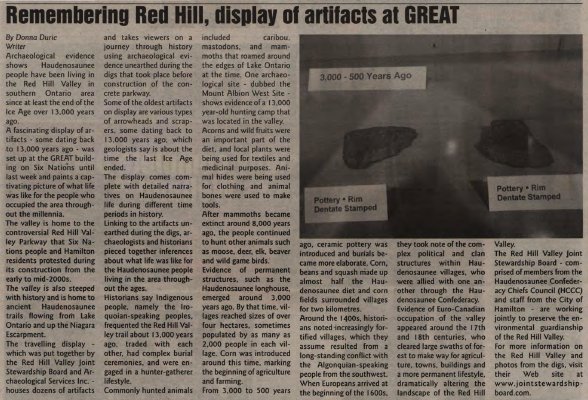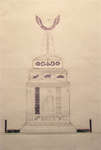"Remembering Red Hill, display of artifacts at GREAT"
- Publication
- Turtle Island News, 9 Jul 2014
- Full Text
- Remembering Red Hill, display of artifacts at GREATBy Donna Duric, Writer
Archaeological evidence shows Haudenosaunee people have been living in the Red Hill Valley in southern Ontario area since at least the end of the Ice Age over 13,000 years ago.
A fascinating display of artifacts - some dating back to 13,000 years ago - was set up at the GREAT building on Six Nations until last week and paints a captivating picture of what life was like for the people who occupied the area throughout the millennia.
The valley is home to the controversial Red Hill Valley Parkway that Six Nations people and Hamilton residents protested during its construction from the early to mid-2000s.
The valley is also steeped with history and is home to ancient Haudenosaunee trails flowing from Lake Ontario and up the Niagara Escarpment.
The travelling display which was put together by the Red Hill Valley Joint Stewardship Board and Archaeological Services Inc. houses dozens of artifacts and takes viewers on a journey through history using archaeological evidence unearthed during the digs that took place before construction of the concrete parkway.
Some of the oldest artifacts on display are various types of arrowheads and scrapers, some dating back to 13,000 years ago, which geologists say is about the time the last Ice Age ended.
The display comes complete with detailed narratives on Haudenosaunee life during different time periods in history.
Linking to the artifacts unearthed during the digs, archaeologists and historians pieced together inferences about what life was like for the Haudenosaunee people living in the area throughout the ages.
Historians say Indigenous people, namely the Iroquoian-speaking peoples, frequented the Red Hill Valley trail about 13,000 years ago, traded with each other, had complex burial ceremonies, and were engaged in a hunter-gatherer lifestyle.
Commonly hunted animals included caribou, mastodons, and mammoths that roamed around the edges of Lake Ontario at the time. One archaeological site - dubbed the Mount Albion West Site shows evidence of a 13,000 year-old hunting camp that was located in the valley.
Acorns and wild fruits were an important part of the diet, and local plants were being used for textiles and medicinal purposes. Animal hides were being used for clothing and animal bones were used to make tools.
After mammoths became extinct around 8,000 years ago, the people continued to hunt other animals such as moose, deer, elk, beaver and wild game birds.
Evidence of permanent structures, such as the Haudenosaunee longhouse, emerged around 3,000 years ago. By that time, villages reached sizes of over four hectares, sometimes populated by as many as 2,000 people in each village. Corn was introduced around this time, marking the beginning of agriculture and farming.
From 3,000 to 500 years ago, ceramic pottery was introduced and burials became more elaborate. Corn, beans and squash made up almost half the Haudenosaunee diet and corn fields surrounded villages for two kilometres.
Around the 1400s, historians noted increasingly fortified villages, which they assume resulted from a long-standing conflict with the Algonquian-speaking people from the southwest. When Europeans arrived at the beginning of the 1600s, they took note of the complex political and clan structures within Haudenosaunee villages, who were allied with one another through the Haudenosaunee Confederacy.
Evidence of Euro-Canadian occupation of the valley appeared around the 17th and 18th centuries, who cleared large swaths of forest to make way for agriculture, towns, buildings and a more permanent lifestyle, dramatically altering the landscape of the Red Hill Valley.
The Red Hill Valley Joint Stewardship Board - comprised of members from the Haudenosaunee Confederacy Chiefs Council (HCCC) and staff from the City of Hamilton - are working jointly to preserve the environmental guardianship of the Red Hill Valley.
For more information on the Red Hill Valley and photos from the digs, visit their Web site at www.jointstewardshipboard.com.
- Creator
- Duric, Donna, Author
- Media Type
- Text
- Newspaper
- Item Type
- Clippings
- Publisher
- Turtle Island News
- Place of Publication
- Six Nations of the Grand River, ON
- Date of Publication
- 9 Jul 2014
- Subject(s)
- Corporate Name(s)
- Grand River Employment and Training ; Archaeological Services Inc. ; Red Hill Valley Joint Stewardship Board ; Haudenosaunee Confederacy Chiefs Council.
- Local identifier
- SNPL004878v00d
- Language of Item
- English
- Geographic Coverage
-
-
Ontario, Canada
Latitude: 43.2296578680479 Longitude: -79.7850167395019
-
- Creative Commons licence
 [more details]
[more details]- Copyright Statement
- Public domain: Copyright has expired according to Canadian law. No restrictions on use.
- Copyright Date
- 2014
- Copyright Holder
- Turtle Island News
- Contact
- Six Nations Public LibraryEmail:info@snpl.ca
Website:
Agency street/mail address:1679 Chiefswood Rd
PO Box 149
Ohsweken, ON N0A 1M0
519-445-2954




